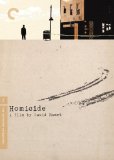| Reviews & Columns |
|
Reviews DVD TV on DVD Blu-ray 4K UHD International DVDs In Theaters Reviews by Studio Video Games Features Collector Series DVDs Easter Egg Database Interviews DVD Talk Radio Feature Articles Columns Anime Talk DVD Savant Horror DVDs The M.O.D. Squad Art House HD Talk Silent DVD
|
DVD Talk Forum |
|
|
| Resources |
|
DVD Price Search Customer Service #'s RCE Info Links |
|
Columns
|
|
|
Homicide - Criterion Collection
THE MOVIE:
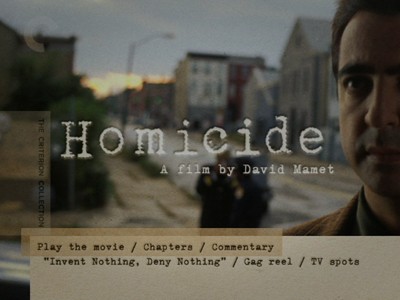
I think that one thing all David Mamet heroes have in common is that they always get more than they bargained for. And just when life piles it on, that's when they find the people they thought they could count on aren't really the exceptional individuals they always gave them credit for. It's the Mamet social contract: when you decide to stand up for something, most everyone else will stand against you.
1991's Homicide was Mamet's third feature as a writer/director, following his acclaimed con-man debut, House of Games, and the lighter departure, Things Change. His lead swindler from Games, Joe Mantegna, returns this time as Bobby Gold, a Chicago police detective known for his gift of gab. He's the guy they call in for negotiations, the one who can talk any skel into giving up information. As an example of these skills, over the course of Homicide, he convinces a brother-in-law and a mother to give up their family member and a dog to give up his meal. Bobby has a way of talking to you that makes even the most nonsensical decision make sense.
Homicide, then, could be described as Bobby Gold giving himself a long dose of his own medicine. Though Gold wants to be working the hot case of the moment, tracking Randolph (Ving Rhames), a cop killer who slipped through the FBI's fingers, helping a couple of rookies in over their heads at a crime scene sticks him with a case of an elderly Jewish shopkeeper shot in the back at her ghetto bodega. Though Bobby at first sees this as a routine case he can mostly ignore--his partner, Tim Sullivan (William H. Macy), advises that he just look busy long enough for it to go away--the further he gets into it, the more he finds. And the more he talks himself into believing and doing.
The deceased is the mother of Dr. Klein (J.S. Block), an influential man amongst Chicago's Jewish leaders. Though his mother continued to run the family store, it wasn't necessary, as her years of labor paid off and her son is now rich, and with those riches comes the ability for Klein to make his mother's shooting a top police priority. The good doctor and his daughter (Rebecca Pidgeon) insist that the attack wasn't about money--the predominantly black neighborhood harbors an urban legend that the old woman had a treasure hidden in her basement--but about her faith and her ethnic background. The victim had been an activist and part of the efforts to establish Israel as an independent state. Even if her murder wasn't directly connected to that, her family believes it was still motivated by an old hate.
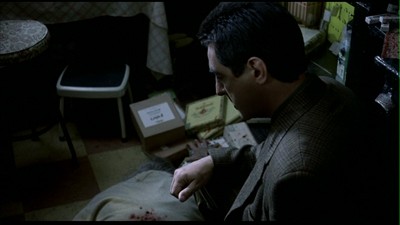
Mamet sets up a complicated racial dynamic in Homicide. Chicago's most wanted, Randolph, is a black man who had the white FBI bust through his door, guns blazing, stirring up tensions in the divided city. Though the cops present themselves as a united front, a single race united by their badge--or "star," as they call it--they haven't entirely melted into one singular race. Sully's Irishness is mentioned, as is Bobby's Jewish heritage. In a moment of anger, Bobby uses the N-word. Only homophobic slurs cross all lines--no one wants to be called one, but the usage is unrestricted.
Still, it's important that we know that Bobby considers himself a cop first and foremost. Not a Jew, nor a Jewish cop, but a cop. He sees himself in the middle, as all police officers do, and that is a suitable stance until people start demanding he take sides. Randolph's mother (Mary Jefferson) is aware that it's a white police force coming after her child, regardless of the different skin tones in the room. She appeals to Bobby's humanity to form some kind of allegiance, but it's already too late. The Kleins have already disparaged his loyalty as a Jew, repeatedly questioning his sense of identity. It gets under his skin, particularly as he starts to discover that the conspiracy the Kleins believe took their mother has some foundation in truth. World War II may have ended more than four decades prior, but a shadow war has continued all these years, conducted in back rooms and hiding behind the veil of "crazy talk." Bobby stumbles into a cabal of Jewish leaders and is even shown a secret Nazi hideout. The challenge repeatedly posed to him: what will you do to protect your people? When will you stop being a cop, stop being neutral, and be a Jew?
Smartly, Mamet's script maneuvers around the political and ideological issues in favor of the personal and emotional ones. There is a sticky morass that the story could be bogged down in. The dead woman may have committed criminal acts in the name of revolution, and there is pressure for Bobby to do the same. It's not really about the larger right or wrong, though, but about how Bobby views the world and his place in it. When it all gets broken down, he isn't sure he's made a fair trade. Being a cop instead of being a Jew seems hollow when Bobby considers the prejudice he has had to overcome. He is always having to prove himself; as Sullivan points out, he's always the first guy through the door to greet danger.
Mamet emphasizes the divides between the many sides in ways that are both class-related and emotionally salient. The most obvious representation of the differences between people is where they live. The ghetto where the old woman was killed is a crumbling ruin while the penthouse where her son lives is immaculate and austere. Bobby repeatedly asks why she kept working "down there," so there is even an above and below. Cinematographer Roger Deakins (a regular collaborator of the Coen Bros.) further illustrates these differences using color and lighting. The ghetto is mostly dark and cold, with lots of grays and blues. Look at that opening scene where the FBI is after Randolph: he practically turns the night air into ocean waters, including the swirling sea foam represented in the smoke that hangs in the air. On the flip, the Jewish homes are white and gold, so warm they practically glow. The racists are associated with red, as seen in both their propaganda flyers and the borders of their swastika flags. Once again, in the middle, the police station is neutral, with no obvious color scheme, nothing to call attention to itself.
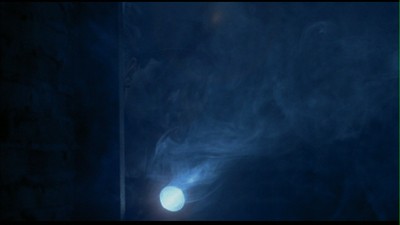
Language is also important, as it is in any David Mamet production. The police have a shared syntax, swapping jargon, completing each other's thoughts, and using abstraction to separate themselves from the world they need to serve and protect. When out in the real world, they adopt a patronizing tone. This is met with a much more laid-back street vibe when in Randolph's neighborhood, but the Kleins and their friends answer in an even more elevated tone than the police. They are actually more patronizing, and they speak to Bobby as if he were a criminal subservient to their authority. It's no wonder that he can't help but be suspicious of their motives or even initially get caught suggesting it's their own behavior that gets the Jews in trouble. Homicide would be a lot less complicated if they made it easier for Bobby to get on board.
Fans of Mamet's work love listening to his dialogue. He has a specific rhythm to his writing that plays out best when two characters are having a back and forth. It's often repetitious, with what one person says being picked up by another and parroted back. In a literal sense, a verbal exchange is occurring. Beyond the construction of his sentences, Mamet also encourages a stilted, dispassionate delivery. (Matching that, the camerawork is fairly straightforward, favoring steady, leveled shots over any visual trickery.) In Homicide, this even-toned way of speaking acts as an equalizer. Everyone is who they are, they are comfortable in their position, no need to get heated about it. The characters that do yell--most notably, Mr. Patterson (Louis Brown), the African American bureaucrat who gets on Bobby's case at the start of the picture--act improperly when they raise their voices. It's an affront to shout and disturb the tranquility of the conversation. It's as if language is the one thing that keeps us civilized. Joe Mantegna is a master of the Mamet style. His voice has a soothing effect when he keeps it low, and he can make it menacing by merely changing the tone, no need to alter the pace or the volume (oh, Fat Tony, how I love you). Next to him, William H. Macy makes for a good foil. There is a twitchy eagerness to his performance that makes it seem his manner of speaking is a genial put-on that he can't wait to burst out of--and at various times, he does.
All of these themes and ideas are worked into what, on its surface, is an average police procedural. Thus, we also get some standard genre scenes with the cops pursuing suspects, etc. The Randolph case goes by the book, whereas the Klein case is less ordered and downright strange. When Bobby goes off on his own, Homicide shifts into a kind of dream world. It's secluded, antiquated, looking the same but not quite. As he would in a dream, Bobby buys into the illusion, even when his instincts suggest maybe he shouldn't. He's trading one star for another, the imperfect pentagram of his badge for the more pliable hexagram of the Star of David. Yet, for his character arc, this is where it all goes wrong. Once Bobby stops being a cop first and foremost, his police work takes a nosedive--a change foreshadowed by the symbol of the broken holster and the gun Bobby can never seem to hang on to. At the same time, the new identity he has embraced isn't wholly him, nor did the people who conned him into it ever expect it to be. Once again, a Mamet lead has had to learn the hard way that oldest of dramatic truisms: to thine own self be true.
This is why at the end of Homicide Bobby finds himself totally alone. He is bruised, battered, and unable to perform the duties of his job. He has become extraneous. I am not sure how I feel about the film's final scene. It doesn't have the gut-punch effect Mamet was hoping for, the attempt at an ironic "What was it all for?" seeming to be tacked on for no real purpose. It's a film noir convention, the ending that renders the rest of it pointless, the hero getting gutshot or the money blowing away in the rain. Granted, there were more obvious ways to go, and Mamet teases us by making us think the prisoner who has throughout Homicide been promising to explain the nature of true evil Bobby is finally going to give up the goods. This could have led to some very hammy writing, and really, saying nothing is much stronger and carries its own suggestions: evil is what casts us out, what demands our silence, what erases the lifeline of language. That would have been enough, the image of Bobby sitting alone while life continues without him would have sufficed. The extra reveal comes off as trying too hard in a movie that up until then didn't have to.
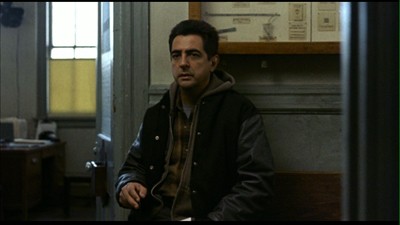
THE DVD
Video:
The 1.85:1 transfer on the Homicide - Criterion Collection DVD is of excellent quality, with a crisp and clean image. The colors look good and there is no interlacing or problems with pixilation. The tones appear in line with the film stock used in the early 1990s, with only a little grain.
Sound:
Homicide is mixed in stereo and has a nice balance in the soundtrack. There isn't much by way of multiple speaker interplay, but the dialogue is clear and the sound effects have punch.
There are optional English subtitles for the deaf and hearing impaired.
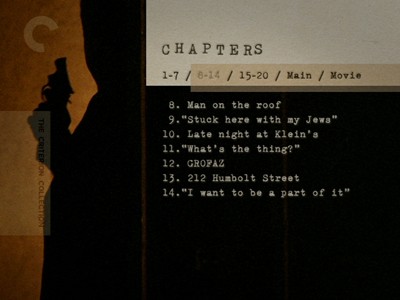
Extras:
Homicide comes in a clear plastic case and a booklet with a fairly extensive essay by writer Stuart Klawans. There are also cast and crew credits and a chapter listing, but instead of the usual photographs, the booklet has artwork by Paul Jackson that, in conjunction with the stylish DVD cover, creates a unified package.
David Mamet and actor William H. Macy have recorded a full-length audio commentary to go with the feature. The two walk down memory lane together, going over their theatre history and the production. In addition to specific stories about the movie, including discussing research and technical aspects, they also theorize on the nature of drama, writing, acting, police work, anything even tangentially related to Homicide. Two smart men who love their craft--this one is a winner. Their friendship also helps keep it light.
Usual suspects from David Mamet films are rounded up for interviews in "Invent Nothing, Deny Nothing." Joe Mantegna, Steven Goldstein, J.J. Johnston, Jack Wallace, and Ricky Jay all worked with Mamet before Homicide, either on stage, in film, or both, and most worked with him after, too. This piece, just over 21 minutes, gives an impression of the author from the guys who worked in the trenches with him and are loyal to him, the soldiers to his general.
Finally, we get a gag reel and a handful of TV commercials for Homicide. The gag reel is just over 6 minutes and features both bloopers and the cast joking around.
FINAL THOUGHTS:
Highly Recommended. David Mamet's Homicide takes the police procedural and turns it into one man's personal journey through religion, race, and identity. Joe Mantegna is at his best as Detective Robert Gold, a Chicago police officer whose accidental connection to the murder of an old Jewish woman leads him to question himself and his beliefs. Mamet creates a bizarre, dream-like world and builds a compelling mystery that never fails to surprise. The Homicide - Criterion Collection DVD sports a fantastic new transfer and a few well-chosen extras to make an all-around great package.
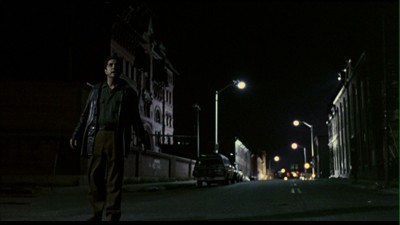
Jamie S. Rich is a novelist and comic book writer. He is best known for his collaborations with Joelle Jones, including the hardboiled crime comic book You Have Killed Me, the challenging romance 12 Reasons Why I Love Her, and the 2007 prose novel Have You Seen the Horizon Lately?, for which Jones did the cover. All three were published by Oni Press. His most recent projects include the futuristic romance A Boy and a Girl with Natalie Nourigat; Archer Coe and the Thousand Natural Shocks, a loopy crime tale drawn by Dan Christensen; and the horror miniseries Madame Frankenstein, a collaboration with Megan Levens. Follow Rich's blog at Confessions123.com.
|
| Popular Reviews |
| Sponsored Links |
|
|
| Sponsored Links |
|
|
| Release List | Reviews | Shop | Newsletter | Forum | DVD Giveaways | Blu-Ray | Advertise |
|
Copyright 2024 DVDTalk.com All Rights Reserved. Legal Info, Privacy Policy, Terms of Use,
Manage Preferences,
Your Privacy Choices | |||||||









